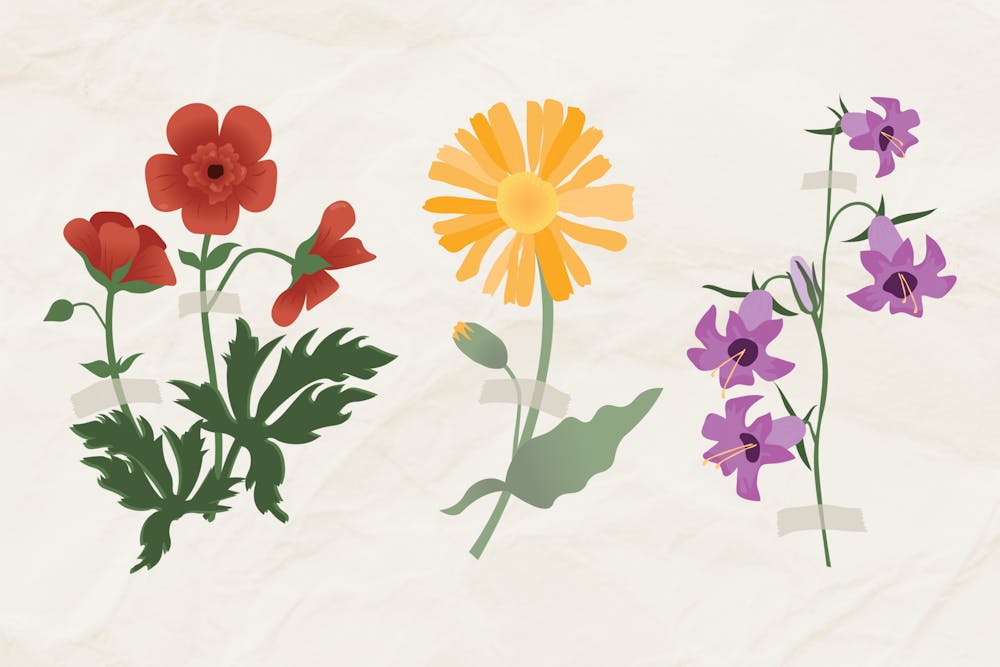In the garden next to Lieber College, Donita Harris cuts back a dying plumbago plant. Harris, USC's assistant horticulturist, points out that the plant typically does well in this part of campus because of the heat from the brick and underground steam pipes. The January snow had done the plant in.
Harris is part of the two-person horticulture team, along with USC horticulturist Charlie Ryan. Horticulturists are experts in plants and garden management. They care for the plants around the Horseshoe, the President's Greenhouse and the large USC smokestack. Ryan and Harris get to choose what ultimately springs out of the ground: This year it is traditional flowers like daffodils and the exotic foliage of the Bed of Nails. Their work contributes to the sights and smells that mark springtime on campus.
This small team is tasked with what Harris calls fine-gardening. They are allowed to have an artistic vision in the gardens, but this vision comes with the responsibility of caring for historic perennials.
“I think that the first sign of spring is the daffodils,” Harris said.
Ryan — who retired in February with 40 years of experience, after 20 at the university — said that around 1,000 new flowering bulbs have been planted this spring. This is down from the two-to-three thousand bulbs that have been planted in past years. He cited a smaller budget as a restricting factor.
The horticulture team used to oversee all flower beds on campus, but now with only two full-time employees, the university has subcontracted out this work to keep costs down.
Flowering trees are an important part of the spring flowers that make up campus, particularly when the horticulture team is unable to plant as many bulbs as they bloom year after year.
“Right out front (by Colloquium), there's a about a 15 to 20 foot Buckeye tree. It's got this big red flower. Absolutely, that's got to be one of my favorites on campus,” Kevin Curtis, the university arborist, said.
The buckeye tree marks the start of Curtis’ favorite path on campus. He said the path around Gibbes' Green (the circle between McKissick Museum and Capstone) provides a cascading effect of trees and bushes blooming. Blooming plants give off unique scents, perfuming the surrounding area.
“(Next to the Visitor Center) there is probably the biggest fragrant tea olive in Columbia, and it blooms two to three times a year,” Curtis said. “And when you walk through back there when it's blooming, not only is it like 40 feet tall and full of blooms, but the smell ... it smells like your grandma's bathroom.”
The sweet scent is familiar as it has been used in soaps and perfumes. Curtis said it always makes him react when he smells it.
Ryan said the scent of the tea olive mixes with those of the magnolias, gardenias and roses to perfume the campus.
Roses are the quintessential example of fragrant flowers. In the rose garden by Lieber college, Ryan and Harris maintain rose bushes that are over 20 years old. One of these is the “very dark red, very fragrant” Mister Lincoln rose.
“We'll cut it back and we put glue on the cuts," Ryan said. "You see this is glue from last year. If you don't, there's a bore that will go in there and hollow out the stem, lay an egg and come back out.”
Pests and disease can disrupt well-entrenched rose bushes, but special knowledge is required to maintain the roses. Every cut the horticulturists make is a decision that impacts the life and production of the plant.
“We don't want anything to be commercialized,” Harris said. “We want it to be unique and eye-catching. It makes people stop and appreciate plants if they're a little bit different.”
Interim First-Lady Patricia Moore-Pastides particularly enjoys an exotic plant that sits near the front gates of the Horseshoe.
“Mrs. Pastides’ favorite plant ... she calls them the tractor seat plant. They have the big round leaf, they're at the front of the Horseshoe,” Ryan said.
This is just one tropical-looking plant that calls USC home. Watch out for Bed of Nails, a relative of the tomato that features its namesake spiky leaves along with orange ping pong ball-sized fruits.
“(Bed of Nails) is from the Caribbean area and they take the fruit — it's full of sweet juice, but it's also packed with 1,000 seeds,” Ryan said. “So, they squeeze the juice and they ferment it and make a cheap wine out of it.”
Edible plants make up a nice portion of campus. A labeled herb garden is next to Russell House and edible plants are often used as ornamental.
“Anywhere there's edible things, we encourage people to (pick some),” Ryan said.
Ryan said his department will bring herbs from around campus to the Healthy Carolina farmers market, including rosemary and bay leaves. Fruit trees are also scattered across campus.
“(My arborist) made loquat cobbler and he said it was better than peach cobbler,” Curtis said. “Thing about loquats is if your stomach's not used to them, start slowly or it works just like ex-lax.”
Curtis said student involvement could help the university plant and maintain fruit trees.
"I've always had a vision of integrating fruits into the landscape," Curtis said. "But it's hard to get people to help you maintain that. Especially students because y'all leave."

